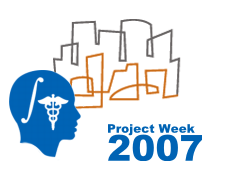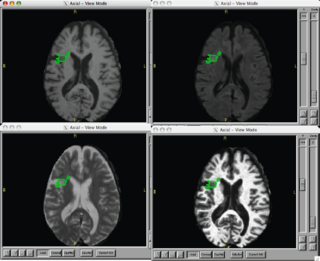Difference between revisions of "ProjectWeek200706:LesionClassificationInLupus"
From NAMIC Wiki
Hjbockholt (talk | contribs) |
|||
| Line 32: | Line 32: | ||
<h1>Progress</h1> | <h1>Progress</h1> | ||
| − | + | * Provided Kilian Pohl and example anonymous demo case with raw t1, t2, and flair, and coregister t1, t2, flair and manual lesions. | |
| + | * Mark Scully has installed current Slicer3 and run the EMSegment tutorial with tutorial data | ||
| + | * We are currently struggling with trying to get the EMSegment module to work on the lupus sample data set | ||
| + | |||
</div> | </div> | ||
Revision as of 15:28, 27 June 2007
Home < ProjectWeek200706:LesionClassificationInLupus Return to Project Week Main Page |
Key Investigators
- MIND/UNM: Jeremy Bockholt, Mark Scully
- MGH:Bruce Fischl
- UIowa: Vincent Magnotta
Objective
Our goal is to automatically, or with little or no manual human rater input, accurately tissue classify our example lupus data-set into gray, white, csf, and lesion classes.
Approach, Plan
Our approach is to utilize existing automatic lesion classification techniques, both within NA-MIC kit and external to it.
Our plan for the project week is to learn and use EMSegment (S. Wells), BRAINS2 (V. Magnotta), and Constructing Image Graphs for Lesion Segmention (M. Prastawa). We will learn and begin to compare and contrast these approaches with a bronze standard (manual rater tracings) of lesions.
Progress
- Provided Kilian Pohl and example anonymous demo case with raw t1, t2, and flair, and coregister t1, t2, flair and manual lesions.
- Mark Scully has installed current Slicer3 and run the EMSegment tutorial with tutorial data
- We are currently struggling with trying to get the EMSegment module to work on the lupus sample data set
References
Additional Information
Using an exemplar case that has already been processed using non-NAMIC kit tools:
- Use existing NA-MIC kit to coregister T1, T2, Flair
- Use the EM Segment in slicer 2-3.X to classify grey, white, csf, and white matter lesion
- Summarize the volume and location of lesions
